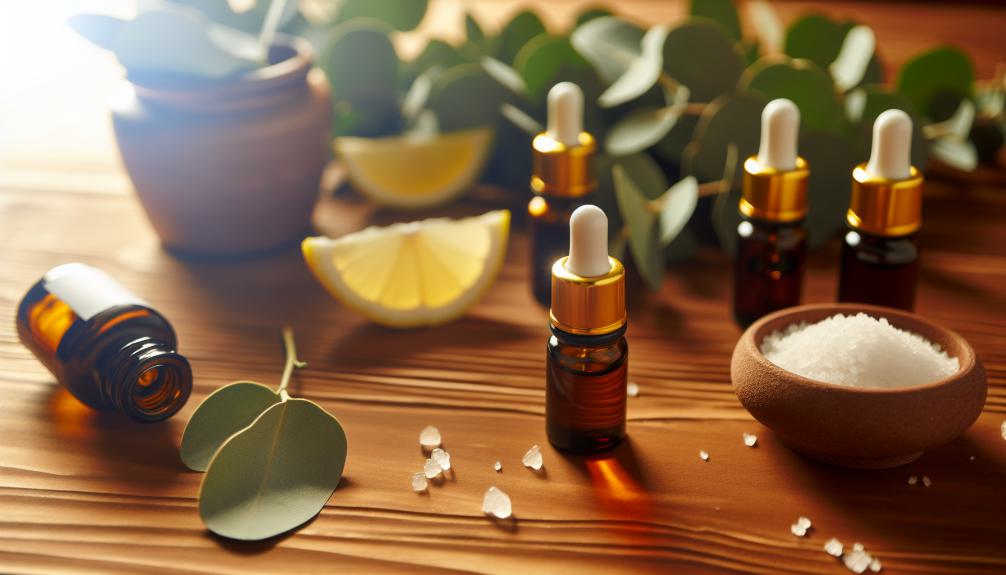
Essential Oil for Earache: Natural Remedies That Actually Work
Essential Oil for Earache: Effective Natural Remedies
For earache relief that actually works, try diluted tea tree oil for its antimicrobial properties or lavender to reduce inflammation and calm pain. You'll need to mix 2-3 drops with a tablespoon of carrier oil like coconut or olive oil, then apply around (not in) the ear. Eucalyptus can help open clogged passages while peppermint creates a soothing cooling sensation. These natural remedies target the root causes of your discomfort without harsh chemicals.
Key Takeaways
- Tea tree oil effectively fights bacterial ear infections with its proven antimicrobial properties when properly diluted.
- Lavender essential oil reduces ear inflammation and provides pain relief while calming anxiety associated with earaches.
- Always dilute essential oils with carrier oils like coconut or olive oil using a 2-3:1 tablespoon ratio for adults.
- Apply diluted oils only behind or around the outer ear, never directly into the ear canal.
- Eucalyptus oil helps relieve pressure by opening blocked passages and has been linked to faster ear infection recovery.
Understanding How Essential Oils Combat Ear Pain
How exactly do essential oils work their magic on those painful earaches? It's all about their natural properties. Most essential oils contain anti-inflammatory and antimicrobial compounds that help reduce swelling and fight infection—two common culprits behind ear pain.
When you apply these oils (properly diluted, of course), they're absorbed through your skin or through inhalation. Think of them as nature's little SWAT team, targeting pain and inflammation right where it hurts.
Oils like lavender and tea tree can calm irritated tissue, while eucalyptus helps open up clogged passages. Unlike some medications that just mask symptoms, essential oils actually target the root causes. They're like that friend who doesn't just tell you everything's fine, but actively helps solve your problem!
Top 5 Proven Essential Oils for Earache Relief
Now that you understand how these natural remedies work, let's look at the most effective options for your earache toolkit. These five oils have consistently shown the best results for ear pain relief.
| Essential Oil | Benefits |
|---|---|
| Tea Tree | Fights bacterial infections with powerful antimicrobial properties |
| Lavender | Reduces inflammation while calming anxiety from pain |
| Eucalyptus | Opens blocked passages and relieves pressure (like a mini plumber!) |
| Peppermint | Creates a cooling sensation that numbs discomfort |
Proper Dilution and Application Methods for Safety
You'll need to properly dilute essential oils with a carrier oil before applying them anywhere near your ears to prevent irritation or damage.
For earaches, it's safer to apply the diluted mixture behind or around your ear rather than directly into the ear canal, which can lead to serious complications.
Before using any essential oil blend, even properly diluted ones, always perform a patch test on your inner arm to check for potential allergic reactions.
Carrier Oil Mixing Ratios
When mixing essential oils for earache relief, proper dilution with a carrier oil isn't just recommended—it's absolutely essential for safety. The standard ratio to remember is 2-3 drops of essential oil per tablespoon (15ml) of carrier oil for adults.
For children over 6, cut that in half to just 1 drop per tablespoon.
Think of it like making lemonade—too much lemon (essential oil) and it's undrinkably strong; too little and you can't taste it at all. Olive, coconut, and sweet almond oils make excellent carriers due to their skin-friendly properties. For quick ear relief, jojoba oil is particularly effective as it closely mimics your skin's natural oils.
Always mix in a clean glass container and test a small amount on your wrist before applying near sensitive ear areas.
Behind-Ear vs. Canal Applications
Understanding the difference between behind-ear application and ear canal application is a matter of both effectiveness and safety. Never put essential oils directly into your ear canal—that's like sending a SWAT team when you only needed a friendly neighbor! Instead, apply diluted oils behind the ear or around the outer ear.
Behind-ear application is your safest bet. Simply massage a few drops of your properly diluted oil mixture onto the mastoid bone (that little bump behind your ear). This allows the oil to absorb through your skin while keeping it away from sensitive inner ear structures.
If you're dealing with outer ear discomfort, you can gently apply the diluted mixture around the ear opening, but remember—stay on the outside! Your ear canal is sensitive territory that deserves respect.
Patch Testing First
Before diving into essential oil use, patch testing should be your non-negotiable first step—like checking the water temperature before jumping into a pool. Even "natural" remedies can cause reactions, especially in sensitive ear areas.
- Mix your chosen oil with a carrier oil (1-2 drops essential oil per teaspoon of coconut or olive oil)
- Apply a small amount to your inner forearm
- Cover with a bandage and wait 24 hours
- Check for redness, itching, or irritation before using near your ears
If you experience any reaction, that oil isn't your friend! Remember, what works wonderfully for your neighbor might turn your skin into a tomato impression. Safety first—your ears will thank you!
Research-Backed Benefits of Aromatherapy for Ear Infections
How exactly can essential oils help with ear infections when conventional medicine seems so dominant? Science is catching up to what many have known for generations. Recent studies show tea tree oil has potent antimicrobial properties that combat the bacteria causing ear infections. Lavender isn't just for sleep—research confirms it reduces inflammation and pain around the ear canal.
You'll love this: scientists found that inhaling certain oils actually boosts your immune response. It's like giving your white blood cells a pep talk! Studies published in the Journal of Alternative Medicine showed patients using eucalyptus oil experienced faster recovery times than control groups.
Don't toss your antibiotics yet, but these natural remedies have earned their place as complementary treatments. They're especially valuable for mild infections or for relief while waiting for medication to kick in.
Essential Oil Blends and Recipes for Different Ear Conditions
Now that you've seen the science behind essential oils for ear health, let's get practical with specific blends you can make at home. These recipes target different ear conditions with precision, like a custom-tailored suit for your ear troubles!
Here are four effective blends to try:
- Basic Earache Relief: 2 drops lavender + 1 drop tea tree + 1 tablespoon warm olive oil
- Infection Fighter: 1 drop eucalyptus + 1 drop thyme + 1 drop oregano + 1 tablespoon coconut oil
- Swimmer's Ear Solution: 2 drops tea tree + 1 drop basil + 1 tablespoon apple cider vinegar
- Tinnitus Calmer: 2 drops cypress + 1 drop juniper berry + 1 drop helichrysum + 1 tablespoon jojoba oil
Remember to always dilute properly and test on skin first. Your ears will thank you!
When to Choose Natural Remedies vs. Seeking Medical Care
While natural remedies like essential oils can be wonderful for minor ear discomfort, knowing when to put down the dropper and pick up the phone for medical help is critical. Trust your instincts—your body usually tells you when something's seriously wrong.
| Symptom | Try Natural Remedies | Seek Medical Care |
|---|---|---|
| Mild discomfort | Yes - gentle oils may help | No - unless persistent |
| Fever | No - oils won't help | Yes - immediately |
| Discharge | No - could be infection | Yes - within 24 hours |
| Hearing loss | No - serious symptom | Yes - same day |
| Severe pain | No - needs evaluation | Yes - emergency care |
Preventative Approaches Using Essential Oils for Ear Health
Rather than waiting until ear pain strikes, you can incorporate essential oils into your regular wellness routine as preventative measures. Think of your ears like your teeth—regular maintenance beats emergency repairs any day! Creating a simple ear health regimen with essential oils can help keep infections at bay and maintain proper ear function.
Try these four preventative approaches:
- Dilute 1-2 drops of tea tree oil in a carrier oil and apply around (never inside) the ear once weekly
- Use lavender oil steam inhalation during cold season to keep nasal passages clear
- Apply diluted eucalyptus behind the ears before swimming or flying
- Massage diluted peppermint oil at the base of the ear and jaw to improve circulation
Conclusion
You've now got a natural toolkit for tackling those pesky earaches! Remember, essential oils can be powerful allies when used correctly, but they're not miracle workers. Always dilute properly, follow safety guidelines, and know when it's time to call the doctor. With these aromatic remedies in your wellness arsenal, you're well-equipped to soothe ear discomfort and support your body's healing process naturally.
